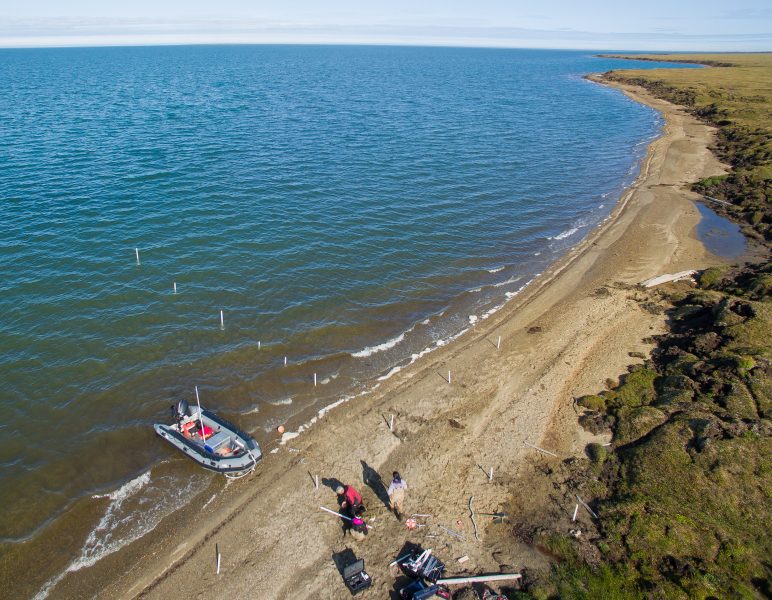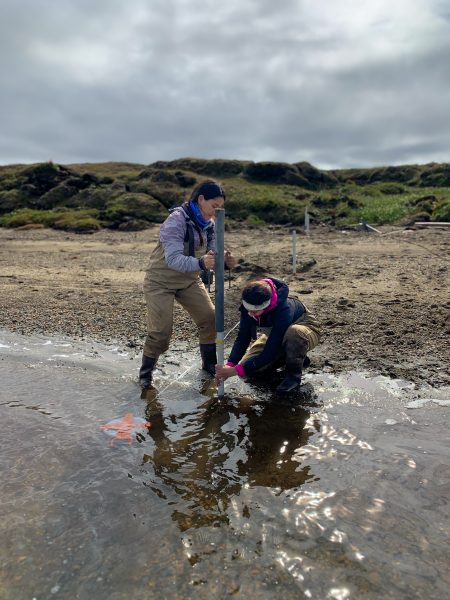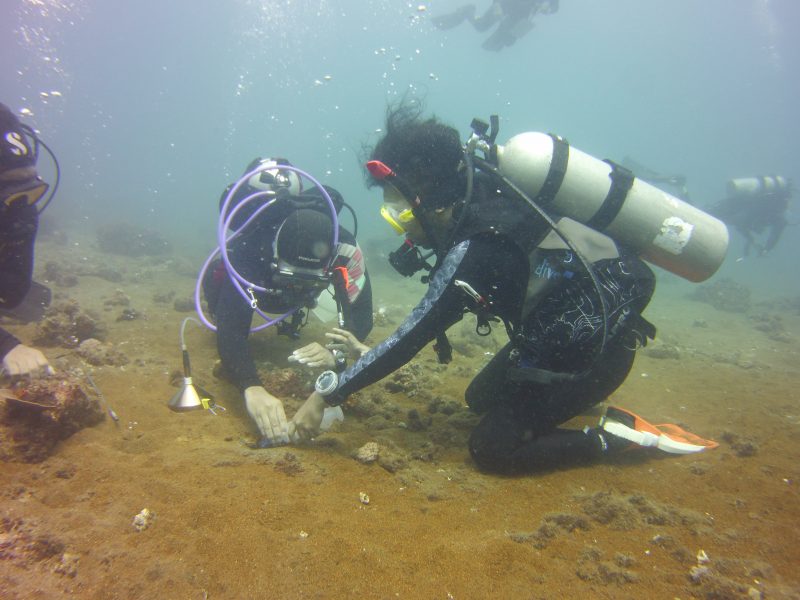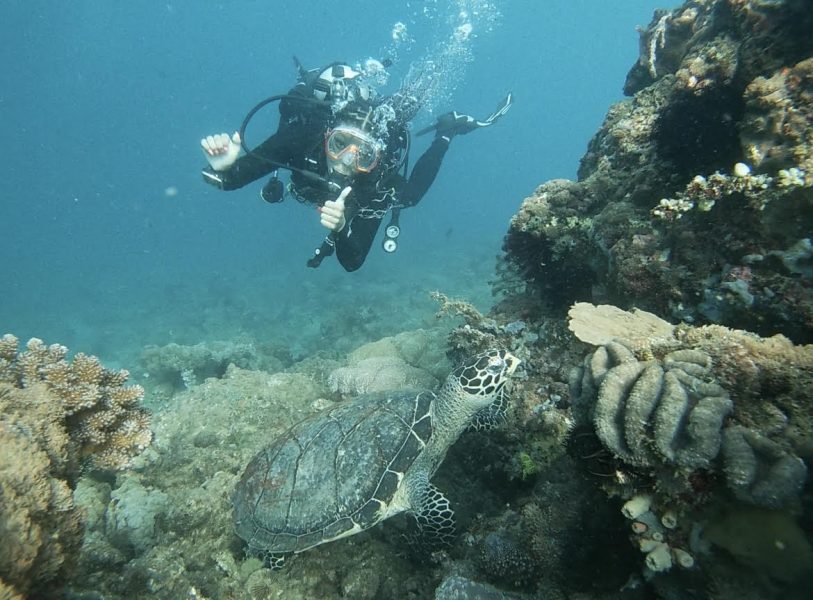When Groundwater Reaches the Coast, it Brings Hidden Risks Along With it
January 30, 2025

A pair of research papers out of the Jackson School of Geosciences report on the presence of groundwater in coastal environments in two very different settings — freshwater just above the freezing point in northern Alaska, and near-boiling volcanic groundwater in the Philippines.
A relatively small amount of groundwater trickling through Alaska’s tundra is releasing huge quantities of carbon into the ocean, where it can contribute to climate change, according to Cansu Demir, who led this research while earning a doctoral degree at the Jackson School.
Researchers found that although the groundwater only makes up a fraction of the water discharged to the sea, it’s liberating an estimated 230 tons of organic carbon per day along the almost 2,000-kilometer coastline of the Beaufort Sea in summer. This quantity of carbon is on par with what free-flowing rivers in the area release during summer months.
“This study shows that there’s humongous amounts of organic carbon and carbon dioxide released via fresh groundwater discharge in summer,” said Demir, who is now a postdoctoral research associate at Los Alamos National Laboratory.
The research was published recently in Geophysical Research Letters.
As the tundra continues to thaw and the flow of submarine groundwater ratchets up, Demir said that the outflow of carbon from shore to sea could effectively make ocean surface waters a carbon source to the atmosphere. The CO2 released via groundwater could also contribute to ocean acidification.

The study is first to use direct observations to show that fresh water is being discharged into the submarine environment where the coast meets the sea. Before this research, the existence of fresh submarine groundwater discharge in this area of the Arctic was thought to be very limited, Demir said.
The study is also the first to isolate freshwater — which could be made up of rainwater, snow melt, thawed shallow ground ice, and potentially some permafrost thaw — from the total groundwater discharge. Previous studies of groundwater discharge in the Artic included recirculated saltwater, which seeped into the ground from the coast.
Using direct observations, numerical modeling, thermal and hydraulic techniques, researchers found that during the summer, fresh groundwater entering the Beaufort Sea north of Alaska is equal to 3-7% of the total discharge from three major rivers in that area. This volume of water is surprisingly high, according to Demir, who said it’s comparable to fresh groundwater discharge amounts in the temperate regions of lower latitudes. And although the volume of groundwater is proportionally small to the overall river flow, it holds a comparable amount of carbon.
“In that small amount of water, that groundwater carries almost the same amount of organic carbon and nitrogen as rivers,” she said.
Groundwater travels beneath the surface through soils and sediments as it makes its way to the coast, picking up organic matter, inorganic matter, and nutrients on its journey. When it interacts with permafrost, it can receive especially large volumes of carbon. Permafrost is akin to a subterranean estuary – holding large volumes of water and organic matter. When the ice melts and becomes part of the groundwater flow, it can bring a huge quantity of carbon along with it.
“The Arctic coast is changing in front of our eyes,” said Bayani Cardenas, a co-author of this study and professor at the Jackson School’s Department of Earth and Planetary Sciences. “As permafrost thaws, it turns into coastal and submarine aquifers. Even without this thawing, our studies are among the first to directly show the existence of such aquifers.”
In addition to contributing to global climate change, this huge influx of carbon and nitrogen could have major impacts for Arctic coastal ecology, Demir said. For example, ocean acidification could lead to increased vulnerability of some of the organisms that live on and under the seafloor, such as crustaceans, clams, and snails.
As permafrost continues to thaw under climate change, the amount of freshwater making its way to the sea underground will potentially increase, delivering even more greenhouse gases into coastal waters.

On the other side of the globe in the Philippines, Jackson School graduate student Ebony Williams found that a significant amount of volcanic groundwater was seeping out along the seafloor, having identified the heated water along 30 kilometers of coastline. Her research was also published in Geophysical Research Letters.
This groundwater heats up to temperatures nearing 180 degrees Fahrenheit due its proximity to magma plumes in the deep subsurface of the island. The groundwater keeps this heat signature as it travels through the aquifer and to the coast, Williams said.
Using the presence of heat in the ocean as a proxy for the flow of volcanic groundwater, Williams and other researchers used a mix of four different thermal sensing techniques to quantify its flow: satellite thermal remote sensing, drones, temperature sensing along an 800-meter-long fiber-optic cable and vertical thermal profiling using elongated rods with temperature sensors that were placed intermittently along the seabed. This is the first time these combinations of methods have been used to measure and detect submarine groundwater discharge in this region of the Philippines.
The groundwater springs on the seabed are varying in size. The larger plumes, some as large as 155 square meters, could be detected via satellite; the smaller ones, as small as 25 square centimeters, were detected using the other tools, Williams said.
The study area is in a region that is home to 76% of the world’s shallow water reef-building coral species. The fact that the coral is surviving while immersed in groundwater that is so hot, so acidic and so rich in carbon dioxide, could point to their adaptability as ocean temperatures rise worldwide, according to the researchers
Cardenas, who is also a co-author on this paper, said learning more about coral diversity and adaptability is the ultimate goal. Some local Filipino coral reef experts are now doing research on this topic, he said.
“I would hope that some ‘super corals’ are present in the area and they can be mined for strategies on how coral reefs might adapt [to climate change] and can be helped,” he said.
This research also shows how groundwater pollution could affect coastal water quality and chemistry. Now, land and water managers in the Philippines have information on where the groundwater emerges along the coast.
“They have a better idea of where that groundwater may come out and how that may affect the fish they hunt for and that supply their industry,” Williams said.
